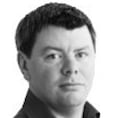James Crombie knew nothing about birds when this all started. Couldn’t have told you a starling from a swallow. When a friend told him he should take some pictures of the murmurations around Lough Ennell, his first job was to go away and google what the hell a murmuration was.
That was four years ago. Ireland was in the maw of the pandemic and the normal run of his day job as a sports photographer had slowed to a crawl. He was looking for something to divert himself and also to distract his buddy, who had recently been through a family tragedy. And so began, in December 2020, a project that would produce the most famous photograph he is ever likely to take.
Crombie’s astonishing bird-shaped murmuration didn’t just go viral, it went global. It appeared first on the front page of The Irish Times on March 4th, 2021 and from there, it went everywhere. To parts known and unknown – National Geographic, CNN, The New Scientist, everywhere else.
“In the three years since I took it, I’d say not a day goes by without someone mentioning it to me,” Crombie says. “I’ve taken pictures since then that I personally think are better but they will never get the attention that that picture got. I go to the UK and run into photographers over there and they go, ‘Here’s the Bird Man’. Every weekend, it happens somewhere.
RM Block
“Which is fine and great – it’s not as if I’m hiding from it. I’m publishing a fecking book off the back of it! But it is funny trying to live up to it. And I don’t think I ever will or ever can, really. I spent the year after I took it half-annoyed because I was going, ‘How am I going to get the next thing that causes that sort of reaction?’ I felt this pressure to deliver something else as good as it.”
But as everyone who ever did anything good knows, reaction is an unstable pleasure. It’s a dopamine hit. It doesn’t last and it can’t be why you do it. Crombie took The Bird photo on his 50th night going to Lough Ennell. He kept going back for another 250 nights over the following three years. Why?
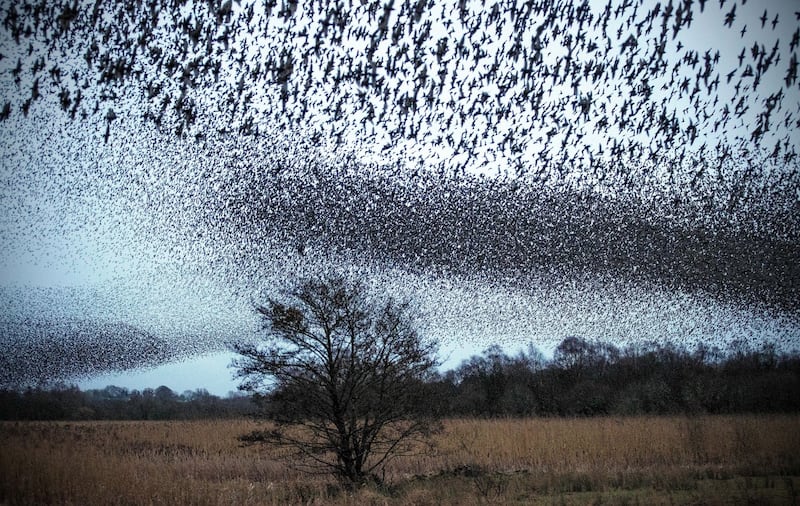
Well, he did it because it became a way to spend time with his friend. He did it because he made another friend, a local farmer, along the way and the three of them became ever so slightly obsessed with these birds. He did it because it was a change of pace too, because there’s only so many kicks you can get from the rolling schedule of live matches.
“It’s funny because I get completely consumed by sport. Last weekend I was at the Aviva and there were 50,000 rugby fans there. And then I was in Twickenham with 82,000 people and then I was in Cardiff with 52,000 people. So at the weekend, I worked in front of nearly 200,000 people.
“And then on the Tuesday night I went to the lake where there was nobody. It was quiet and peaceful and I just thought, I love the contrast in that. I kind of need that as well. Because you go from game to game, they often just become the same thing at a different venue. I’m as mad into it as I ever was but I know it’s not possible to produce amazing photographs from every event you go to. I know that sometimes you do a match in cruise control.
“So to go down to the lake and just be there, knowing that nobody is going to care what I produce or if I don’t produce anything, I like that. I’m there on my own, I’m not on the phone, there’s no pressure.”
Crombie has won plenty of awards down the years, twice taking the overall PPI Photographer of the Year gong. And yet, much like with the starlings, he ended up being a snapper almost by happenstance. He did an aptitude test in secondary school and somehow the career guidance answer that came back said he should be a fishmonger. He ended up in IT and went to London for three years, working in a bank. That was never going to be it, either.
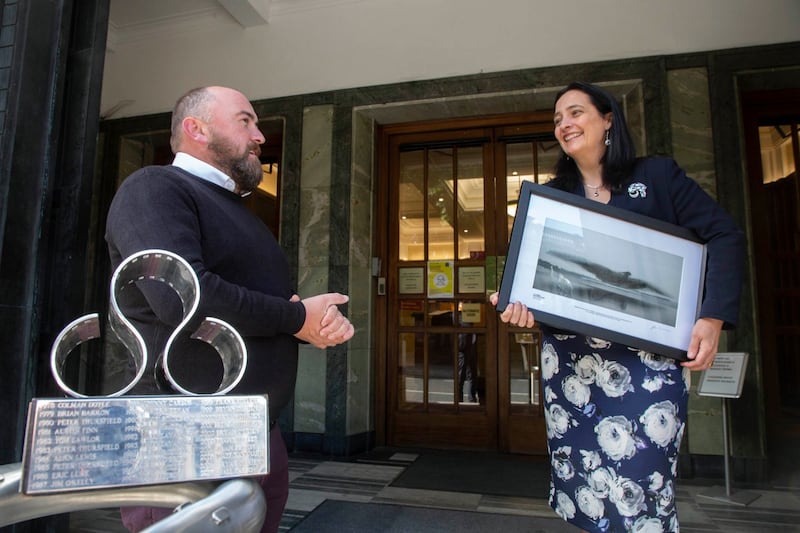
All the while, he was interested in photography, as a hobby as much as anything. He came back to Ireland and tootled about in a couple of other jobs for a while until a chance came along to take part in a reality TV series called No Experience Required. The idea was that various companies – among them the Inpho sports photography agency – would audition people who had never worked in a particular area before and at the end, take them on to the staff for six months.
“I always joke with Billy [Stickland, founder of Inpho] that if I hadn’t won that show, I’d be earning 300 grand a year now and have a second villa down in Spain. But no, I chose sport and photography instead. And it’s been amazing.
“I would say it took me 10 years to get comfortable with it. I was obsessed from the start. For most of that first six months, I was sitting in the office obsessed with how the other lads were cropping pictures, obsessed with settings, obsessed with the equipment. Eventually, near the end, one of them said to me, ‘Here, are you not going to go out and take any pictures? They won’t keep you on if you don’t.’
“It nearly hadn’t occurred to me that I could go out and take them, weird as that sounds. I half-thought I had to stay in the office. So I went out every night to a different football match – Dublin championship, intermediate games, junior games, down to Wicklow for more games then. I still have those pictures and they’re brutal. But that’s how it started.”
The bulk of the job is matches. Rugby, soccer, hurling, football, wash, rinse, repeat. He brings an analogue radio with him to every match – digital radio commentary is always about 40 seconds behind the action. It means that he can be looking around during a game, staying engaged but still able to find pictures away from the pitch.
“I think you need to keep some element of nervousness when you go to games. You don’t want to be too comfortable. If Dublin or Limerick are attacking in the last play of an All-Ireland final, your nerves have to be high because you don’t want to miss the shot.
“I remember this year with Clare and Cork in the All-Ireland final, the Clare guy pulled the Cork guy’s jersey – I got a great shot of it. The jersey is nearly off him. I really thought, ‘How is that not a free?’ This is going to be the pivotal shot. And it didn’t become the pivotal shot because the free wasn’t given.
“Those last shots are where you have to be nervous. I’d say something like that happens maybe 10 times in a year. You know it, you can feel it in the stadium, the last play is so important and you don’t want to mess it up. You need that little bit of edge.”
The murmuration project was entirely without edge, of course. Which was kind of the point. Crombie is married to Ann – they’ve been together since they were teenagers and have four kids. Having a day job that takes him away at weekends and sometimes for weeks at a time is bad enough. Heading off to hang out with a couple of thousand starlings for 300 nights over four years requires a fair bit of understanding on the home front.
“I would definitely say it’s selfish on my part. I’m gone a lot with sport in the first place. And then to find another reason to be away, it’s a lot. But I met my wife when we were 17. We know each other that long. She manages me, as much as people would have managed Paul McGrath back in the day. Occasionally she’ll say, ‘Right, cop on here.’ But she knows me better than anyone.”
When the book arrived a couple of weeks back, Crombie’s initial reaction surprised him a little. Delighted and all as he is with it, he couldn’t help being sad at the whole thing coming to an end. Or at least an end of sorts.
The starlings have been coming to Lough Ennell to roost in winter for as far back as anyone can remember. It’s about half an hour’s drive from his house. He’ll never not be able to head out with his camera to shoot them. Will he ever snap another picture like the one he did three years ago? Probably not. Will he ever stop being asked about it. Equally probably not.
One answer that has never been properly nailed down is the why of it. Why did those thousands of starlings form themselves into the shape of a bird of prey that evening in April 2021? Murmurations are for protection, that much is well known. But why that particular shape for that particular millisecond? Pure coincidence? Or something deeper?
“I’d like to think it’s something deeper,” Crombie says. “There was another shape that looked like a water wren that same night, within three or four minutes of the one I got. But I’m pretty sure it’s just by chance. I’ve had comments over the years saying it’s a sign of the end of the world, praising Allah, praising God, whatever else. I don’t know.
“I don’t think they did it on purpose. If I was standing at a slightly different angle, it wouldn’t have looked like a bird. We just happened to be at the exact perfect angle. So I don’t know. It was probably just pure chance.”
♦ Murmurations by James Crombie is published by Lilliput Press
The art of sports photography: How It Works
Fionn McGivern (2) watches Kilkenny v Clare, July 2023
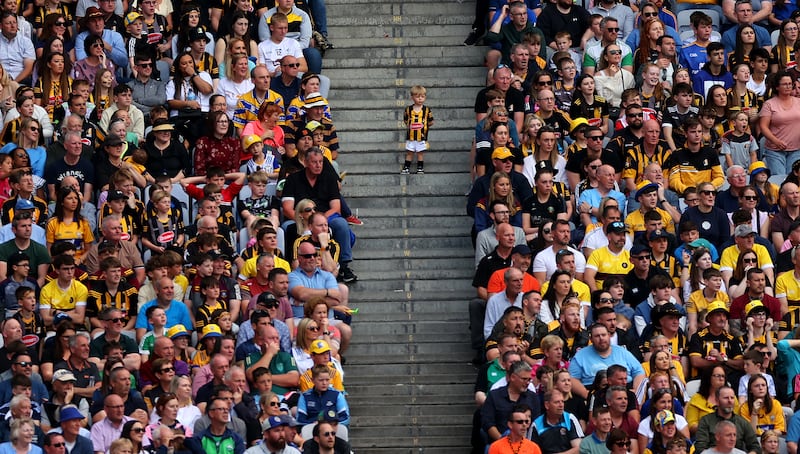
I was watching this little kid for about seven or eight minutes while the game was going on. I was very relaxed that day. I was looking for something different and I remember spotting that little kid out of the corner of my eye. I had the game going on in my little analogue radio so I knew I could turn and get anything if I needed to.
But this little lad was just there and I followed him for about seven or eight minutes, maybe nine. Just waiting for him to get into that perfect stance, the way he is in the shot. I got a great buzz out of it.
The kid was from Antrim. His parents were massive Kilkenny fans. They were down for the game. Somebody found them afterwards and did a story on them and they ended up getting tickets for the final because of it. The kid ended up being interviewed on Kilkenny radio. That one was good fun.
Supporter at Covid-era club championship match, September 2020
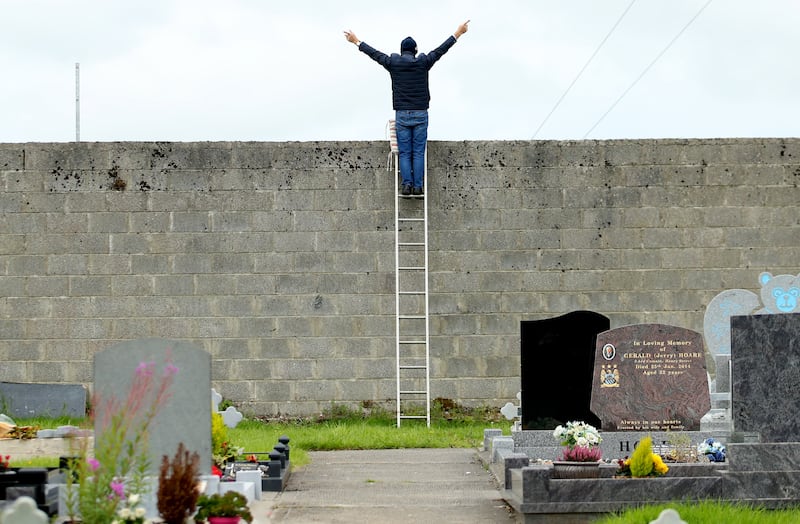
Sport had just started back but no crowds were allowed at games yet. This was a Roscommon semi-final between St Brigid’s and Boyle. I was taking pictures of it when I saw this head poking up over the wall behind the goal. So I said I’d go out and have a look.
I got out into this graveyard behind Dr Hyde Park. This guy had carried his ladder all the way through the graveyard and propped it up. I didn’t want to disturb him in case he fell off so I took a few snaps and happened to get this one just as Boyle scored.
I went over to him then and asked could I publish the photo. “Oh Jesus no,” he said. “I’m not supposed to be here.” There were still restrictions at that stage on how far from your house you were allowed to go. But I said I wouldn’t use his name and would only show him from the back so he was okay with it.
A few weeks later, his daughter got on to me and asked could she get the original. Apparently it went viral and everyone recognised him. He ended up doing a two-page spread in the Roscommon Herald.
Connacht bench at a Challenge Cup game in Siberia, January 2016

This was a mad adventure. Enisei-STM were the first Russian club to play in the Challenge Cup and Connacht went to Siberia for the game. We were told there could be up to 30,000 at it – we turned up and there were about 400 there. It was the coldest I’ve ever been, the harshest conditions I’ve ever seen a match be played in.
I had about a dozen layers on me and I was still frozen solid. I saw the Connacht bench from the far side of the pitch but it took me about 10 minutes to walk around because I nearly seized up with the cold. They had blankets and hot water bottles and hot chocolates for when they came off the pitch.
It took us about a week to get home. The charter plane Connacht had hired hadn’t moved for four days and was completely frozen solid when we got back to it. So we had no way of getting out of there. By the time we did, our five-day visas had run out. We had to fly to Moscow to get our visas renewed just to leave the country. Players got processed first, officials next. I’d say I was pretty much the last one out.
- Sign up for push alerts and have the best news, analysis and comment delivered directly to your phone
- Join The Irish Times on WhatsApp and stay up to date
- Listen to our Inside Politics podcast for the best political chat and analysis

